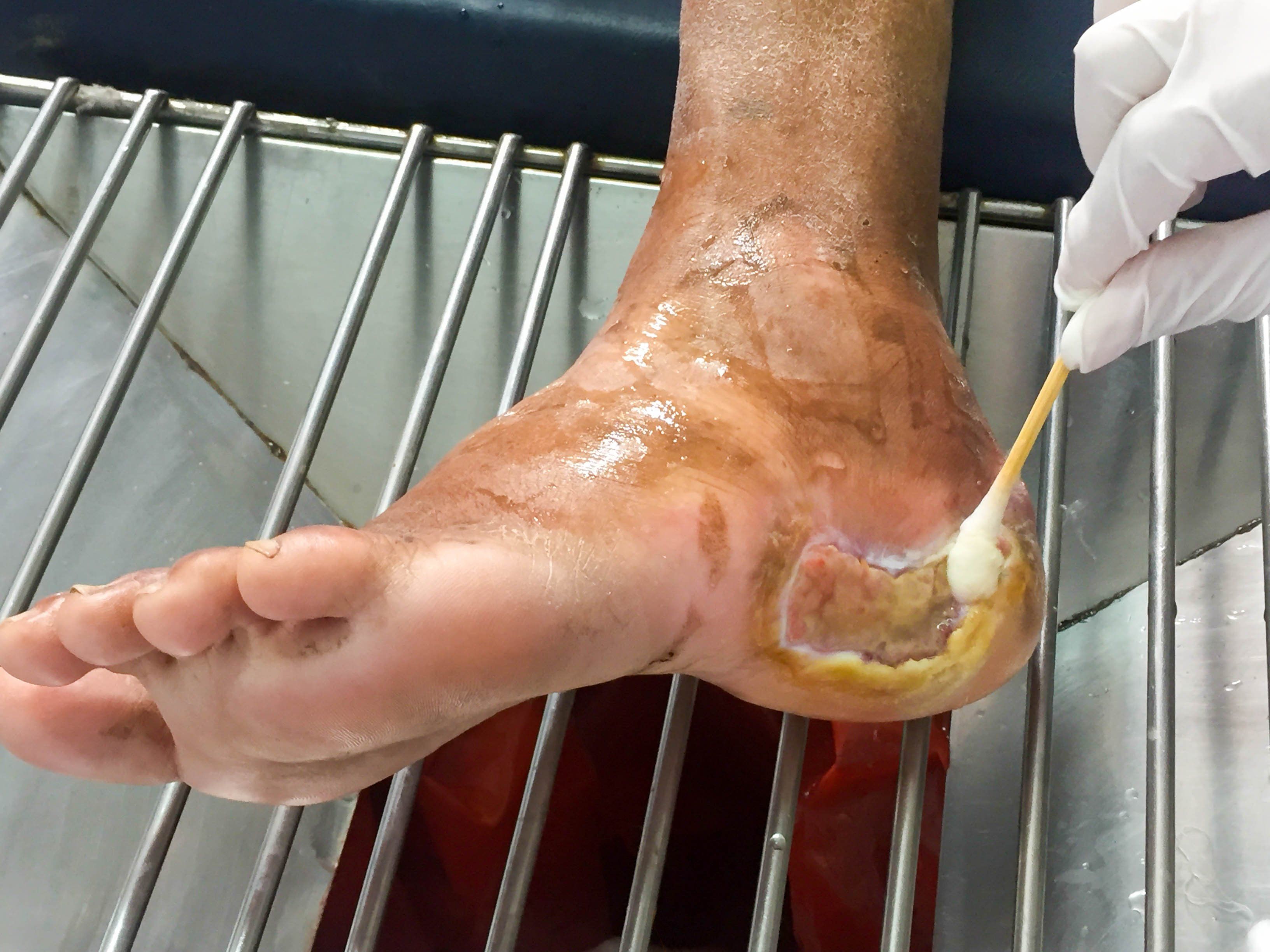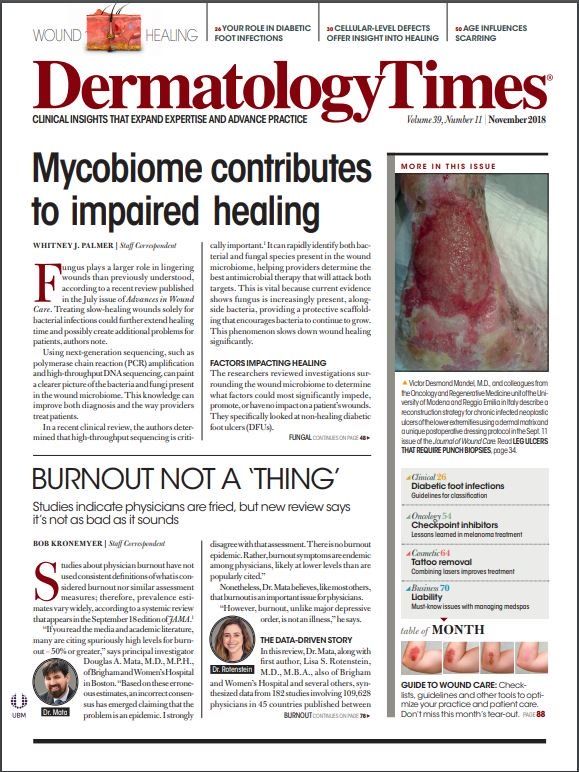- Case-Based Roundtable
- General Dermatology
- Eczema
- Chronic Hand Eczema
- Alopecia
- Aesthetics
- Vitiligo
- COVID-19
- Actinic Keratosis
- Precision Medicine and Biologics
- Rare Disease
- Wound Care
- Rosacea
- Psoriasis
- Psoriatic Arthritis
- Atopic Dermatitis
- Melasma
- NP and PA
- Skin Cancer
- Hidradenitis Suppurativa
- Drug Watch
- Pigmentary Disorders
- Acne
- Pediatric Dermatology
- Practice Management
- Prurigo Nodularis
- Buy-and-Bill
Publication
Article
Dermatology Times
Mycobiome contributes to impaired wound healing
Author(s):
Identifying the presence of bacterial and fungal species improves antimicrobial therapy, according to a recent review published in the July issue of Advances in Wound Care.
Identifying the presence of bacterial and fungal species improves antimicrobial therapy, according to a recent review published in the July issue of Advances in Wound Care. (memorisz - stock.adobe.com)

Fungus plays a much larger role in lingering wounds than previously understood, according to a recent review published in the July issue of Advances in Wound Care. Treating slow-healing wounds solely for bacterial infections could further extend healing time and possibly create additional problems for patients, the authors note.
Using next-generation sequencing, such as polymerase chain reaction (PCR) amplification and high-throughput DNA sequencing, can paint a clearer picture of the bacteria and fungi present in the wound microbiome. This knowledge can improve both diagnosis and the way providers treat patients.
In a recent clinical review, the authors determined that high-throughput sequencing is critically important.1 It can rapidly identify both bacterial and fungal species present in the wound microbiome, helping providers determine the best antimicrobial therapy that will attack both targets. This is vital because current evidence shows fungus is increasingly present, alongside bacteria, providing a protective scaffolding that encourages bacteria to continue to grow. This phenomenon slows down wound healing significantly.
Factors impacting healing
The researchers reviewed investigations surrounding the wound microbiome to determine what factors could most significantly impede, promote, or have no impact on a patient’s wounds. They specifically looked at non-healing diabetic foot ulcers (DFUs).
The skin cracks associated with DFUs make these wounds particularly vulnerable to the introduction of fungus, the authors wrote.
“Fungal foot infections, although often overlooked, are dangerous in that they create a portal of entry for secondary bacterial infection through fissures and splits,” they said. “Toenail infections in particular, left untreated, increase the risk of developing a foot ulcer and subsequent infection-related complications.”
Existing research indicates the presence of fungi in the DFU wound microbiome often goes under-identified. According to one 2011 study that examined yeast and fungi in chronic wounds, 23% tested positive for fungi.2 But, nearly 41% of DFUs were fungal positive, and the predicted fungal:bacterial ratio was more than 50%. Another study, focusing exclusively on DFUs found 28.6% were fungi-positive based on microscopic examination, but only 20% were positive by culture.3
These findings, according to the authors, suggested fungi is present, but standard microbiology laboratory protocols do not detect it in more than 25% of DFUs, supporting the assertion that culture-dependent methods underestimate diversity and bioburden.
To get a better picture of how fungi impact wounds, the authors cited their own follow-up research using PCR-based amplicon sequencing of the fungal internal transcribed spacer region to more specifically pinpoint the prevalence and structure of fungal communities in DFUs over six months. They found highly-diverse fungi were present in 71.6% of DFU specimens and in 79% of wounds within a 26-week study.4 Importantly, researchers saw patients who received systemic antibiotics had much higher fungal diversity in wounds than those who didn’t.
“This suggests that using antibiotics solely targeting bacteria may create an environment favorable to fungal colonization and expansion,” the authors wrote.
Increased fungal diversity was also linked to worsening wound environments, suspected bacterial infections, and an increase in prescribed antibiotics.
Fungal species
Previous research indicates more than 75% of commonly-isolated yeasts in DFUs were from the genus Candida spp.5 In fact, the same three species - Candida parapsilosis, Candida tropicalis, and Candida albicans - were present in more than 30% of fungi-positive wounds. The review authors also identified, using high frequency, a clear distribution of wounds with high proportions of pathogenic or allergenic fungi, such as Cladosporium spp. and Aspergillus spp. These fungi and others, the authors said, are linked to poor outcomes, including open wounds that remained after six months of treatment. Fungal pathogens are also highly associated with wound necrosis which frequently leads to amputation.
Additionally, the investigators discovered, chronic rhinitis, like DFUs, is associated with polymicrobial colonization and biofilm formation. The allergenic fungi were linked to larger and longer-lasting wounds, but they weren’t associated with hemoglobin A1C or white blood cell counts that impact foot ulcers. These findings further indicate fungi found in slow-healing wounds is underestimated and needs further investigation, they said.
“Exclusion of fungi from DFU microbiome analysis is shortsighted because the healthy skin microbiome comprises bacteria and fungi,” they wrote. “Moreover, the feet have been shown to exhibit the highest level of fungal diversity within the skin microbiome, with many species considered opportunistic pathogens. Culture-dependent and culture-independent studies focusing on fungi have consistently revealed that a significant portion of chronic wounds, such as DFUs, are colonized or infected with fungi.”
The researchers also hypothesized that, as a mixed bacterial-fungal community, the wound microbiome would facilitate interactions between both gram-positive and gram-negative bacteria and fungi to form multi-species biofilms. Existing data shows fungus promotes adhesion to these surfaces and could give bacteria a substrate on which to bind, making it harder for antimicrobial medications to penetrate a wound.
Overall, the authors wrote, these evidence points to the need to expand the arsenal of medications used to fight these infections. Using only drugs that target bacteria can lead to the flourishing of fungi in wound tissue and open the door for fungal infections to spread.
“Current treatments for wounds with suspected biofilm are primarily focused on targeting bacteria,” they said, recommending providers prescribe fluconzaole to decrease the mean healing time for a DFU. “There is now sufficient evidence to conclude that increased species diversity of biofilms is correlated to increased resistance to antimicrobials.”
Ultimately, however, they advocated for continued research into the wound microbiome to expand the knowledge base surrounding the relationship between microbial bioburden, wound progression, host response, and other individual characteristics.
REFERENCES:
1 Grice E, Kalan L, Fungi in the Wound Microbiome, Advances in Wound Care (July 2018), doi: 10.1089/wound.2017.0756.
2 Dowd SE, Delton Hanson J, Rees E, et al. Survey of fungi and yeast in polymicrobial infections in chronic wounds. J Wound Care 2011;20:40–47.
3 Mehra BK, Singh AK, Gupta D, Narang R, Patil R. A clinicomicrobiological study on incidence of mycotic infections in diabetic foot ulcers. ijss-sncom. INJSS. 2017;4:50–54.
4 Kalan L, Loesche M, Hodkinson BP, et al. Redefining the chronic-wound microbiome: fungal communi- ties are prevalent, dynamic, and associated with delayed healing. MBio 2016;7:e01058–16.
5 Chellan G, Shivaprakash S, Karimassery Ramaiyar S, et al. Spectrum and prevalence of fungi in- fecting deep tissues of lower-limb wounds in patients with type 2 diabetes. J Clin Microbiol 2010;48:2097–2102.







